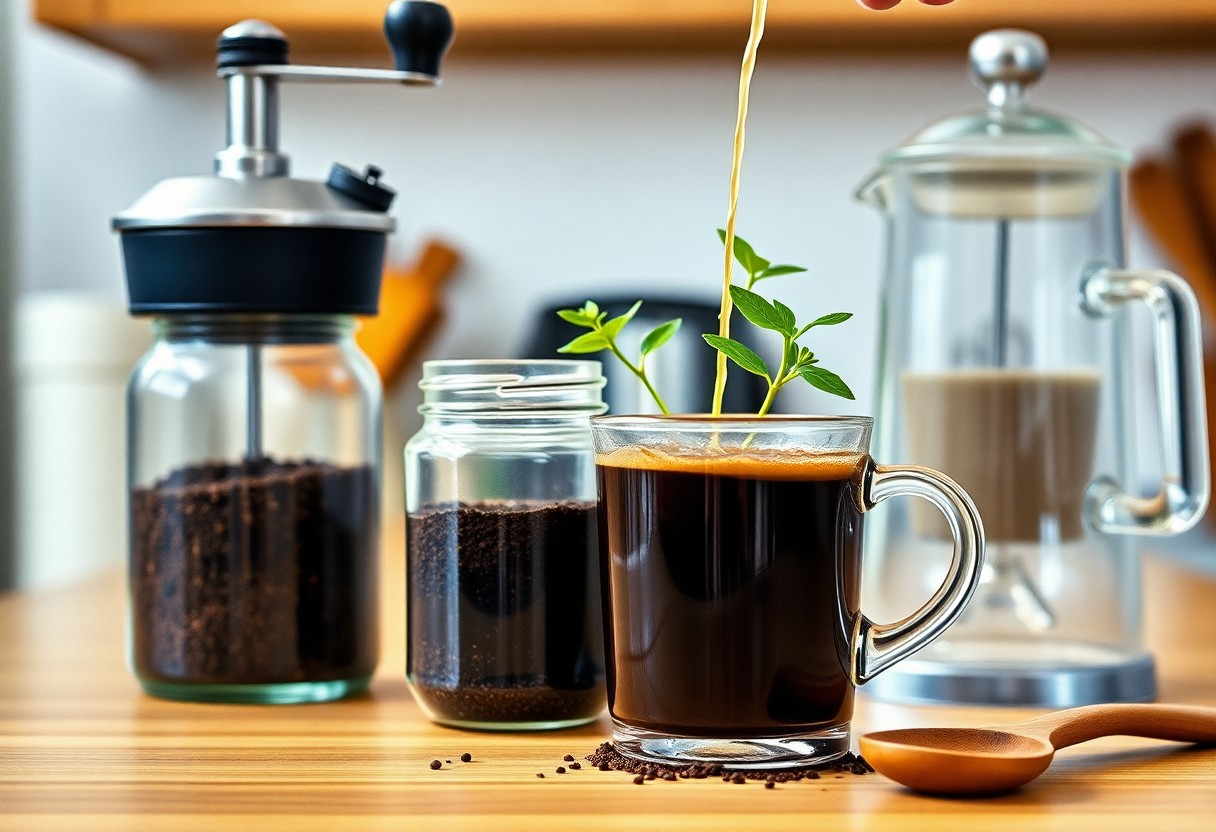Zero-waste coffee brewing is not only a sustainable choice, but it also enhances your morning routine. By making intentional choices from the selection of beans to the way you dispose of grounds, you can significantly reduce your environmental footprint. In this guide, you’ll discover eco-friendly techniques and practical tips that transform your daily brew into an environmentally conscious ritual. Learn how to repurpose coffee grounds, choose sustainable brewing methods, and enjoy every sip knowing your cup is as green as it is delicious.
Key Takeaways:
- Utilize coffee grounds by repurposing them as natural fertilizers for plants, deodorizing agents, or for creating homemade soaps and scrubs.
- Opt for reusable filters or a French press instead of disposable coffee filters to significantly reduce waste during the brewing process.
- Rethink water usage by using just the right amount needed for brewing to avoid excess that results in wasted coffee and water.
From Bean to Brew: Selecting Your Coffee
Opting for the right coffee is pivotal for both flavor and sustainability. When identifying your coffee beans, consider your brewing preferences and source your beans ideally from local roasters or specialty shops. Freshly roasted beans not only taste better but also reduce carbon emissions associated with long-distance travel. Aim for whole beans instead of pre-ground coffee, as whole beans retain their flavor longer and yield less waste during preparation.
Choosing Sustainable Coffee Sources
Prioritize coffee that is certified organic or Fair Trade, ensuring fair wages for farmers and sustainable growing practices. Consider exploring local coffee roasters who emphasize direct trade relationships with farmers. Look for brands that support eco-friendly initiatives, such as using biodegradable packaging, to minimize the environmental impact of your coffee choices.
Understanding Different Brewing Methods’ Impact on Waste
Your choice of brewing method can significantly influence waste production. Some methods, like pour-over and French press, use minimal resources, while single-use pods contribute to a staggering amount of plastic waste. For example, an estimated 29,000 coffee pods end up in landfills every minute, leading to millions of tons of plastic waste annually. Selecting methods that utilize reusable filters or eliminate filters altogether can greatly reduce your coffee footprint.
Ground Zero: The Art of Grinding Coffee with Intention
Grinding coffee beans offers an opportunity to maximize flavor while minimizing waste. By investing time and thought into the grinding process, you’ll discover the subtle nuances of each bean, ultimately elevating your coffee experience. Consider the type of brew you enjoy and how the grind size can affect flavor extraction—this step is important for achieving that perfect cup without unnecessary waste.
Selecting the Right Grind Size for Your Method
Your brewing method dictates the ideal grind size, influencing the strength and flavor of your coffee. For example, a fine grind suits espresso, while a coarser grind works best for a French press. Using the right size ensures optimal extraction and avoids over- or under-brewing, leaving you with a delicious cup tailored to your preferences.
Using Reusable Grinders vs. Disposable Options
Choosing between reusable grinders and disposable options not only impacts your coffee quality but also your environmental footprint. Reusable grinders, like hand cranks or electric burr grinders, deliver consistent results and reduce waste—while disposable grinders contribute to landfill overflow after just a few uses.
Reusable grinders are often more efficient and environmentally friendly than disposable alternatives. Investing in a high-quality burr grinder means you can fine-tune your grind size for various brewing methods over time, saving you money in the long run. On the other hand, disposable grinders generate significant waste with every use. By embracing reusable options, you keep your coffee ritual sustainable and enjoy better flavor profiles that single-use devices fail to capture. Making this one-time investment benefits both your taste buds and the planet.

Waste-Free Brewing: The Process that Delivers
Crafting your coffee with zero waste requires a streamlined process from start to finish. Start by sourcing quality, sustainably-produced beans, preferably in bulk or compostable packaging. Incorporate reusable tools such as metal filters, glass carafes, or cloth bags for steeping. Focus on utilizing your used coffee grounds creatively, whether as compost, natural deodorant, or even a skin exfoliant. Every step counts in minimizing waste and making your coffee ritual more eco-friendly.
Setting Up Your Brewing Station for Minimal Waste
Your brewing station plays a pivotal role in reducing waste. Use dedicated containers for your coffee beans to eliminate single-use packaging and invest in high-quality equipment that lasts. Keep a compost bin nearby for used grounds and a jar for repurposed items like coffee-infused beauty products. A well-organized station not only makes your experience seamless but also reinforces sustainable practices.
Brewing Techniques that Optimize for Sustainability
Adopting brewing techniques focused on sustainability can significantly impact your waste footprint. Techniques like the pour-over and French press allow for maximum flavor extraction without relying on disposable pods or filters. You can enjoy a rich cup of coffee while minimizing your environmental impact. Even methods like cold brew can be tailored to your needs by utilizing a reusable filter, making each sip guilt-free.
For example, in pour-over brewing, you have full control over the water flow, ensuring optimal extraction without excess waste. Switching to a metal mesh filter eliminates the need for paper filters, which often end up in landfills. With the French press, you can enjoy a robust cup without any extra filters or pods. Pair these methods with fresh, whole beans and grind only what’s needed for your brew. Keeping this eco-conscious approach at the forefront of your coffee-making will support both your palate and the planet.

The Ultimate Cup: Creative Ways to Use Coffee Grounds
The possibilities for reusing coffee grounds extend far beyond your morning brew. From enriching your garden soil to creating natural scrubs or even enhancing your culinary creations, these spent grounds can be transformed into valuable resources. By exploring innovative methods to utilize these grounds, you can significantly reduce waste while discovering new ways to enhance various aspects of your life.
Versatile Applications Beyond the Cup
Think of coffee grounds as a treasure chest filled with versatile applications. You can use them as a natural deodorizer, a gentle abrasive for cleaning, or even as a component in homemade beauty products. Whether you’re crafting an exfoliating face scrub that buffs away dead skin or a coffee-infused seasoning for meats, your used grounds can add flavor and utility in many unexpected areas.
Composting and Repurposing Grounds Effectively
Integrating coffee grounds into your compost pile elevates its nutrient profile while cutting down on waste. Rich in nitrogen, coffee grounds act as a fantastic booster for your composting efforts, accelerating decomposition and enriching the soil with vital nutrients that plants crave. Adding them in moderation—about 25% of your compost mix—ensures an optimal balance and effective processing.
Transforming your coffee grounds into compost is simple and beneficial for your gardening endeavors. By mixing them with other organic materials, you enrich your compost with microbes that aid in breaking down the mix. Furthermore, as they break down, coffee grounds contribute valuable minerals such as potassium, calcium, and magnesium to the soil, making them particularly beneficial for plant health. Sprinkling used grounds directly into your garden beds can also help deter pests and enhance moisture retention, creating a thriving environment for your plants.
Sip Sustainably: Making Eco-Friendly Coffee Choices
Sipping sustainably means making informed decisions about your coffee from sourcing to serving. Choosing organic, fair-trade products not only ensures high quality in flavor but also supports environmentally friendly farming practices. Opting for methods like cold brewing or French press uses less water and energy, aligning closely with your zero-waste goals. With a focus on sustainability, every cup becomes a conscious choice to protect the planet.
Selecting Reusable Materials Over Single-Use
Replacing single-use items with reusable alternatives helps dramatically cut waste in your coffee routine. Invest in a sturdy travel mug, a glass or metal French press, and reusable filters made from fabrics like hemp or stainless steel. These choices diminish landfill contribution and often enhance your coffee experience — a double win for you and the environment.
Exploring Eco-Conscious Brands and Products
Delve into the world of eco-conscious brands that align with your sustainable coffee goals. Look for companies committed to ethical sourcing, such as Intelligentsia and Blue Bottle Coffee, which emphasize direct trade practices. Additionally, brands like KeepCup and Klean Kanteen offer reusable coffee gear designed for durability and minimal environmental impact. Supporting these brands not only helps reduce waste but also fuels a movement toward greener consumerism. Seek out certifications, like Rainforest Alliance or Fair Trade, for a more transparent stewardship.
Conclusion
With this in mind, brewing coffee with zero waste is not only possible but also rewarding. By integrating practices such as composting your grounds, utilizing reusable filters, and sourcing beans responsibly, you can elevate your coffee experience while minimizing your environmental impact. Embrace the journey from ground to cup, knowing that your choices contribute to a sustainable future. Enjoy your delicious cup of coffee, knowing you’ve done your part to reduce waste and promote sustainability.
FAQ
Q: How can I choose the right coffee beans for zero waste brewing?
A: Opt for whole bean coffee from local roasters or specialty shops that offer bulk purchasing options. By choosing whole beans, you can buy only what you need, minimizing packaging waste. Look for brands that prioritize sustainable sourcing, ensuring that the coffee beans are roasted with environmental considerations in mind.
Q: What brewing methods can I use to minimize waste?
A: There are several brewing methods that align with a zero waste approach. Techniques such as French press, pour-over, and Aeropress all use minimal equipment and can eliminate the need for single-use coffee pods. For those methods that traditionally use filters, consider using washable cloth filters or metal filters to cut down on paper waste.
Q: How do I properly dispose of used coffee grounds?
A: Used coffee grounds have numerous beneficial uses beyond the cup. They can be composted, as they are a great source of nitrogen for your compost pile. Additionally, coffee grounds can be used as a natural fertilizer in your garden, as a deodorizer in your refrigerator, or even as an exfoliant in homemade skincare products. Find creative ways to repurpose the grounds to ensure they don’t end up in the landfill.
Q: Is it possible to eliminate packaging when buying coffee?
A: Yes, many local coffee shops and roasters offer the option to bring your own containers for purchasing coffee beans. Some stores may provide bulk bins, allowing you to fill your own reusable bags. Engaging with coffee cooperatives that encourage a zero waste philosophy can also help you find sources that prioritize eco-friendly practices.
Q: What is the best way to clean my coffee brewing equipment sustainably?
A: To clean your brewing equipment in an environmentally friendly way, rinse off the equipment with hot water right after use to prevent residue build-up. For more thorough cleaning, use a mixture of vinegar and water or baking soda, both of which are natural cleaning agents. This approach avoids the use of harsh chemicals, ensuring that your cleanup process aligns with sustainable principles.
